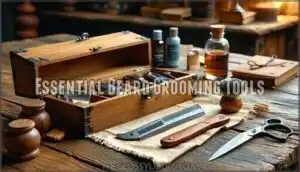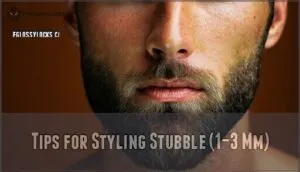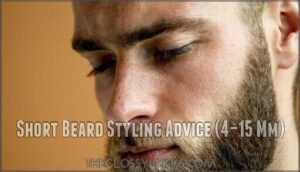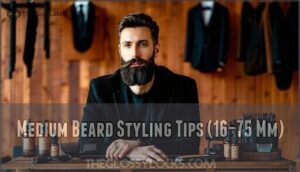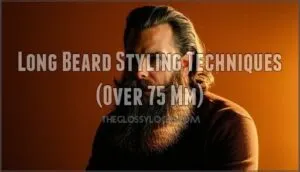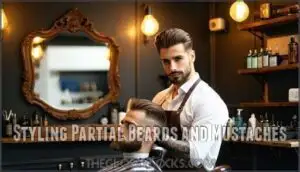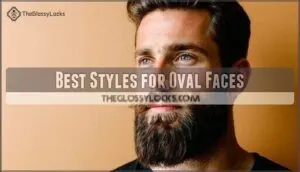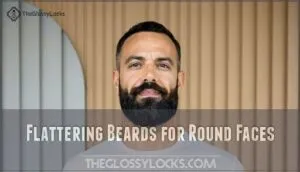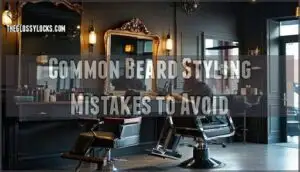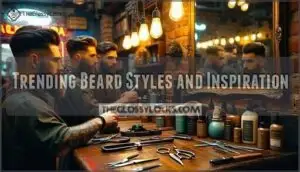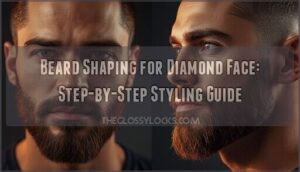This site is supported by our readers. We may earn a commission, at no cost to you, if you purchase through links.
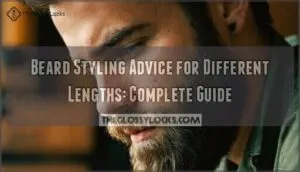
The difference between a beard that sharpens your jawline and one that blurs it comes down to millimeters and angles. Each length range demands its own technique: stubble needs precision edging, short beards require strategic shaping, and longer growth tests your patience with detangling and split ends.
Master the specific tactics for your current length, and your beard transforms from facial hair into a legitimate style weapon that reshapes how people see your face.
Table Of Contents
- Key Takeaways
- Why Beard Length Matters for Styling
- Essential Beard Grooming Tools
- Tips for Styling Stubble (1–3 Mm)
- Short Beard Styling Advice (4–15 Mm)
- Medium Beard Styling Tips (16–75 Mm)
- Long Beard Styling Techniques (Over 75 Mm)
- Styling Partial Beards and Mustaches
- Adapting Beard Styles to Face Shape
- Common Beard Styling Mistakes to Avoid
- Trending Beard Styles and Inspiration
- Frequently Asked Questions (FAQs)
- Conclusion
Key Takeaways
- Your beard length directly reshapes your facial architecture—stubble needs precision edging, short beards (4–15mm) require strategic cheek and neck line definition, medium lengths (16–75mm) demand density management and daily conditioning, while long beards (over 75mm) need detangling techniques and split-end prevention to separate deliberate style from neglect.
- Matching your beard to your face shape transforms facial structure—round faces need vertical emphasis through extended goatees or ducktail styles, square faces benefit from rounded edges that soften angles, and oval faces have the flexibility to experiment with nearly any beard style from Van Dykes to full beards.
- The difference between attractive and sloppy beards comes down to maintenance discipline—research shows 49% prefer heavy stubble for universal appeal, 53% of workplaces favor clean or minimal facial hair, and daily trimming combined with beard oil application prevents the dryness, patchiness, and uneven growth that undermine even months of commitment.
- Common styling mistakes sabotage beard goals faster than poor growth—over-trimming when hair is wet creates uneven cuts, neglecting skin care beneath the beard triggers folliculitis and ingrown hairs, and skipping hydration with quality oils turns facial hair into brittle, uncomfortable wire that screams neglect to anyone within reach.
Why Beard Length Matters for Styling
Your beard length isn’t just a matter of millimeters—it’s the difference between looking sharp and looking sloppy, between commanding a room and blending into the walls.
The right length shapes your face, signals your style, and can even shift how others see you.
Here’s what you need to know about why beard length matters before you pick up that trimmer.
Impact on Facial Features
Your beard isn’t just facial hair—it’s architecture that reshapes your entire face, defining your jawline, balancing proportions, and commanding attention in ways a bare face never could.
The right beard contours bring facial symmetry into focus—they highlight your cheekbones and balance out a larger nose.
When you choose the right style, even a softer jawline can develop sharp, masculine edges that completely change how your face reads.
Master facial hair grooming with male grooming tips that sculpt your features intentionally—because mens grooming isn’t vanity, it’s tactical beard care for maximum impact.
Attractiveness and Style Trends
Beyond reshaping your face, the right beard length places you at the center of Masculine Appeal and Social Perception—heavy stubble drives peak attraction (49% prefer it), while full beards signal dominance and maturity. Here’s what Beard Attraction research reveals:
- Stubble (1–3 mm) wins universally: Most adaptable length for blending attractiveness across age groups and contexts
- Short beards (4–15 mm) dominate professional spaces: 53% workplace preference for clean or minimal facial hair
- Full beards project status: Perceived as more masculine, mature, and capable—especially among men
- Age shapes preference: Younger audiences favor stubble; older demographics (45–60) lean clean-shaven (38%)
- Style Influencers drive adoption: 51% of grooming decisions now stem from influencer content and Facial Hair Trends
Understanding the hormonal influence factors can help in making informed decisions about beard styling.
Match your beard style to what you’re after—whether that’s looking sharp in professional settings or maximizing your appeal on the dating scene.
The right length isn’t just grooming; it’s strategic.
Matching Beard to Personality
The beard you wear broadcasts who you are before you say a word—a stubble-shaded minimalist reads differently than a full-bearded maverick, and choosing the right length means aligning your look with the image you want to own.
Beard Psychology connects Personality Traits to Style Expression: professionals lean toward short, controlled Mens Beard styles for authority, creatives embrace fuller Facial Hair for individuality, and rebels push long lengths to challenge convention.
Your Beard Maintenance routine becomes part of your identity—Facial Harmony and Masculine Attractiveness emerge when Individuality Matters drives your Beard Styles choice.
Essential Beard Grooming Tools
You can’t shape a beard without the right gear in your hands. The tools you choose depend on your beard’s length and the style you’re chasing.
Let’s break down what belongs in your grooming kit.
Beard Trimmers for Every Length
Picking the right trimmer isn’t just about blade quality—it’s about matching the tool to the job, whether you’re maintaining sharp stubble or taming a full mane. Look for adjustable length settings that cover your range—1mm guards for stubble, up to 20mm+ for medium beards.
Cordless options give you freedom and control, while safety features prevent nicks.
Read beard trimmer reviews focusing on your specific beard style and maintenance needs before investing.
Brushes and Combs for Styling
Once your trimmer’s done its work, a quality brush or comb steps in to train your beard into shape and keep it looking sharp throughout the day.
Boar bristle brushes work wonders for beard detangling and distributing natural oils, while wide-tooth combs made from wood or acetate prevent snags and static.
Match brush sizes to your beard’s length—smaller for stubble, larger for full growth. Different comb materials and styling techniques suit various hair textures and beard styles, so experiment to find what tames your mane best.
Beard Oils and Balms
Your beard won’t reach its full potential without the right nourishment—that’s where oils and balms lock in moisture, eliminate itch, and give you that polished finish.
Beard oil benefits your facial hair by conditioning from root to tip, while balms add hold and shape. Look for natural oils like jojoba, argan, and sweet almond in quality products.
- Lightweight oils absorb fast for daily beard conditioning
- Balm ingredients like beeswax provide all-day styling control
- Fragrance options range from woodsy to citrus—or go unscented
- Morning application works best on damp beards after washing
- Start small—a few drops or dime-sized amount prevents greasy buildup
The right oils and balms can take your beard from scruffy to sharp—it’s that simple.
Tips for Styling Stubble (1–3 Mm)
Stubble sits in that sweet spot where you look intentional without committing to a full beard.
It’s adaptable, low-maintenance, and works across face shapes—but only if you dial in the details.
Here’s how to keep your 1–3 mm stubble sharp and deliberate.
Achieving a Clean Edge
Stubble’s biggest challenge isn’t growing it—it’s keeping those edges sharp enough to separate intentional style from "I forgot to shave."
Grab your beard trimmer and define your cheek and neck lines with precision cutting—these clean lines frame your facial hair and transform scruff into deliberate beard shaping.
Edge trimming weekly maintains that intentional look. Don’t freehand it; use your jawbone as a natural guide for facial framing that actually works.
Maintaining Even Length
Even stubble demands consistency—uneven patches turn a clean look into a patchy mess that no sharp edge can rescue. Set your trimmer’s guard to maintain length control across your entire face—don’t just eyeball it.
Regular trimming keeps everything balanced and growing evenly, so your facial hair stays sharp and intentional.
These techniques are what separate a deliberate look from something that just happened—helping your grooming routine actually support the beard you’re growing.
Short Beard Styling Advice (4–15 Mm)
Short beards hit the sweet spot between polished professionalism and masculine edge—they’re the current go-to for men who want presence without the commitment of a full beard.
Getting this length right means mastering three core techniques that separate a sharp look from a sloppy one. Here’s what you need to lock down to make your short beard work for you.
Defining Cheek and Neck Lines
Sharp, defined lines separate a well-groomed beard from one that looks like it just happened—and mastering your cheek and neck boundaries is where real control begins.
Cheek line trimming starts about halfway between your sideburns and mustache—trim above this natural curve and you’ll look patchy.
For neck beard shaping and jawline definition, create your border one finger-width above your Adam’s apple, following your jaw’s natural angle.
This facial hair mapping approach to beard border control transforms basic grooming into precise beard care and maintenance that commands respect.
Balancing Fullness and Shape
A full beard means nothing if its shape fights your face instead of framing it—fullness without direction is just noise.
Trim beard layers to create facial balance: thin the sides if your face runs wide, add volume beneath the chin for length.
Your hair texture dictates styling—coarser growth holds beard symmetry better, while fine facial hair needs strategic face framing.
Master these grooming tips and your beard styles and care become tools for control, not compromise.
Workplace-Ready Beard Maintenance
Professional settings demand more than just shape—your beard needs to look intentional, not like you forgot to shave three weeks ago. Corporate style requires discipline:
- Daily trimming maintains clean cheek and necklines for office grooming standards
- Beard hygiene means washing twice weekly to prevent odor and flaking
- Professional trimming keeps length uniform, showing you respect beard etiquette
- Grooming tips: apply beard oil before meetings—it signals control over mens fashion and beard growth
Medium Beard Styling Tips (16–75 Mm)
A medium beard gives you real styling freedom, but it also demands more attention to keep it looking sharp.
You’ll need to master density-building techniques, tackle any patchy areas head-on, and lock down a daily routine that works.
Here’s how to take control of your medium-length beard and make it work for you.
Enhancing Beard Density
Density separates a groomed beard from one that grabs focus—and building it takes more than wishful thinking. Beard thickening starts at the hair follicle level. Growth supplements boost density from within, while beard fillers temporarily boost coverage. Pair density products with consistent beard care for visible results.
| Strategy | How It Works |
|---|---|
| Growth Supplements | Biotin and vitamins strengthen hair follicles for thicker facial hair |
| Beard Fillers | Keratin fibers cling to existing beard styles, adding instant volume |
| Density Products | Minoxidil-based formulas stimulate dormant follicles for beard growth |
| Proper Beard Care | Regular washing and conditioning prevent breakage, maximizing hair growth |
| Styling Techniques | Strategic trimming creates the illusion of fuller, denser facial hair |
Preventing Patchiness
Dealing with a patchy beard? Genetics play a role—roughly 79% of cases trace back to DNA—but that’s not the whole story.
Smart beard growth strategies can fill in those gaps better than you’d think.
Taking care of your hair follicles makes all the difference. Beard oil, for example, can bump up density by 27% after sixteen weeks of regular use.
Just as important? Steering clear of irritation—harsh products are behind 22% of those stubborn patchy areas.
Building healthy beard habits—think regular grooming, eating right, and keeping stress in check—can actually reshape how your facial hair grows.
Your beard’s likely to fill out more naturally once you’re past twenty-five anyway.
Understanding your unique facial hair growth patterns is essential for effective beard styling.
Daily Care Routines
Once you’ve tackled patchiness, building a solid daily routine keeps your medium-length beard looking sharp without demanding hours of your time. Here’s your morning routine for facial hair:
- Beard washing – cleanse three times weekly to prevent buildup and support beard growth
- Skin exfoliation – scrub beneath facial hair twice weekly to avoid ingrown hairs
- Beard oiling – apply daily for hydration and hair care
- Daily trimming – touch up stray hairs to maintain shape
- Grooming check – quick comb-through ensures polished beard care before you head out
Long Beard Styling Techniques (Over 75 Mm)
Long beards demand more than just patience—they require deliberate technique to keep them commanding instead of chaotic. Your beard has earned its place, and now it’s time to master the skills that separate a wild mane from a statement piece.
Here’s how to shape, maintain, and showcase a long beard that turns heads for all the right reasons.
Shaping for Face Structure
Your long beard isn’t just a statement—it’s a sculpture that either complements your bone structure or works against it, and the difference comes down to strategic shaping. Face shape analysis reveals how beard symmetry transforms facial harmony.
| Face Shape | Shaping Strategy |
|---|---|
| Round | Keep sides trimmed shorter; add length at chin for jawline enhancement |
| Square | Soften angles with rounded edges; maintain fullness for cheekbone accentuation |
| Oval | Most beard styles work—experiment with facial hair that emphasizes your best features |
When you nail the right shape for your face, you’re bridging the gap between solid grooming and genuine style.
Detangling and Conditioning
Keeping up with beard detangling prevents the chaos that ruins your grooming efforts. Work through knots daily using a wide-toothed beard comb, starting from the tips and moving toward your face to minimize breakage.
Hair conditioning products designed for facial hair restore beard hydration and soften coarse strands, making tangle removal easy.
Apply quality beard care oils after washing to maintain moisture and improve beard styling control.
Managing Split Ends and Frizz
Split ends and frizz turn even the most impressive beard into a tangled mess that screams neglect instead of mastery. Combat this with beard serum that locks in moisture and smooths hair texture.
Regular trimming every four to six weeks removes split ends before they worsen. For frizz prevention, apply beard care products daily and avoid over-washing, which strips natural oils your facial hair needs for healthy beard growth and maintenance.
Styling Partial Beards and Mustaches
Partial beards and mustaches aren’t about compromise—they’re about precision and personality. These styles demand deliberate shaping and clean lines to pull off the look without appearing incomplete.
Here’s how to master the most popular partial styles, keep your mustache sharp, and combine elements for maximum impact.
Popular Partial Beard Styles
Partial beards let you break the rules without going all-in—think strategic facial hair that makes a statement while keeping maintenance refreshingly simple. Here’s what dominates the partial beard trends right now:
- Goatee: Classic chin-focused facial hair styles that sharpen your jawline without the commitment of a full beard
- Van Dyke: Disconnected mustache styles paired with chin beard designs—bold and artistic
- Soul Patch: Minimalist facial hair stubble below the lower lip for subtle edge
- Chin Strap: Sharp beard styling that traces your jawline like architectural precision
- Beardstache: Prominent mustache with light stubble everywhere else—effortlessly rugged
Grooming Tips for Mustaches
A mustache without proper grooming is like a sports car without a tune-up—all potential, zero performance. You’ll need mustache wax to tame wild hairs and define your mustache styles, whether you’re rocking a Chevron or Hungarian.
Daily beard care means trimming stray facial hair with precision grooming tools, then conditioning to keep things soft. Master these grooming and styling fundamentals, and your style advice becomes simple: commit to the routine.
Combining Partial Styles for Impact
Mix a Van Dyke with a soul patch, or blend a goatee into a chevron mustache—combining partial styles transforms decent facial hair into a signature look that stops people mid-scroll.
Beard fusion demands facial harmony: match beard texture between sections, trim precisely where styles meet, and let style blending showcase your personality.
Study beard styles for style inspiration, then adapt that style advice to your facial hair—because authentic beard styling beats cookie-cutter trends every time.
Adapting Beard Styles to Face Shape
Your face shape determines which beard styles will work with your natural structure, not against it. The right beard can sharpen a soft jawline, balance out width, or add definition where you need it most.
Here’s how to match your beard to your face for maximum impact.
Best Styles for Oval Faces
Oval face shapes give you the greatest freedom in beard styling—nearly every look works with your naturally balanced proportions. Classic full beards at 12–15 mm improve facial symmetry while projecting confidence. Short boxed beards trimmed to 6–8 mm deliver refined jaw definition perfect for professional settings.
Want more edge? Anchor and Balbo styles introduce sharp angles that emphasize your chin’s natural structure. Even minimalist options like the Van Dyke or soul patch frame your features without overwhelming your facial balance, proving oval faces offer unrivaled style versatility in male grooming.
Flattering Beards for Round Faces
Round faces need vertical emphasis to counteract soft contours and improve facial symmetry. Extended goatees at 14–16 mm visually elongate your profile, while ducktail beards create sharp chin definition through pointed styling.
Angular full beards and tapered shapes between 6–16 mm carve out jawline improvement that transforms beard proportions. Strategic trimming beats length alone—focus beard growth and maintenance on controlled sides with extended chin coverage for prime men’s grooming results.
Choosing Styles for Square and Rectangular Faces
Square and rectangular faces benefit from beard symmetry that softens dominant angles rather than amplifying them. Circle beards blend rounded goatee and mustache styling to counteract strong jawlines, delivering professional mens grooming without harsh edges.
Van Dyke and anchor beard styles use disconnected mustaches and pointed chins for angular styling that redirects attention, while ducktail and Garibaldi beards add vertical definition through strategic barbering techniques.
Face shape analysis guides your beard styling choices—focus on facial hair textures and volume placement for ideal jawline enhancement.
Common Beard Styling Mistakes to Avoid
Even experienced beard growers slip up with habits that sabotage their style goals. Small mistakes compound over time, turning a sharp look into something that reads sloppy or unfinished.
Here’s where most guys go wrong and how you can avoid the same traps.
Over-Trimming or Uneven Cuts
A single slip with the trimmer can undo months of careful growth in seconds—patchy, uneven, gone.
Getting a handle on trimming techniques and knowing your hair texture keeps you from hacking away at your beard’s shape.
To dodge the most common mistakes:
- Always trim when your beard is dry—wet hair appears longer
- Use quality cutting tools with adjustable guards for precision
- Work slowly in natural light to spot uneven areas
- Start longer than your target length when trying new beard styles
Professional barbering techniques demand patience. Your beard trimmer isn’t a race car—control beats speed every time for impeccable beard styling.
Neglecting Beard Hydration
Dry, brittle facial hair doesn’t just look rough—it feels like steel wool and screams neglect to anyone within handshake distance. Beard dryness triggers itchy beards and dandruff issues that sabotage even the sharpest style.
Daily beard oil application keeps facial hair hydrated and soft, supporting healthy beard growth while preventing the wiry texture that ruins your mens grooming game.
Proper hydration tips start with quality beard care products—skip this, and your beard becomes an uncomfortable mess nobody wants to touch.
Ignoring Skin Care Beneath The Beard
Your beard’s foundation—the skin hiding underneath—can sabotage every styling effort if you treat it like an afterthought. Neglected skin breeds beard itch, ingrown hairs, and folliculitis—conditions that turn facial hair maintenance into a daily battle.
Regular beard oil penetrates to nourish the skin beneath, preventing beard skin issues before they derail your cosmetic maintenance routine. Healthy skin means healthier facial hair and fewer men’s health and wellness concerns down the road.
Trending Beard Styles and Inspiration
Your beard isn’t just facial hair—it’s a statement that reflects who you are and where you’re headed.
The styles making waves right now blend classic craftsmanship with modern edge, drawing inspiration from celebrities, global trends, and real beardsmen sharing their journeys online.
Let’s explore what’s capturing attention and how you can find your own signature look.
Celebrity and Influencer Looks
When you’re chasing that perfect look, celebrity beards and influencer trends offer powerful beard inspiration. In 2025, 57% of women rated 5mm stubble most attractive—the same famous style Jimmy Fallon rocks.
Top influencers like Brock O’Hurn command over 2.1 million followers, shaping iconic looks across Instagram and TikTok. These mens grooming and fashion leaders drive premium product sales and mens fashion standards worldwide.
Global Beard Style Gallery
Our global gallery captures thousands of beard styles—from Amsterdam cafés to Tokyo’s underground barber scene.
Each one shows how facial hair transcends borders and becomes a statement of personal style:
- Viking-inspired ducktails from Scandinavia commanding respect
- Precision goatees dominating Seoul’s style evolution
- Wild Bandholz beards celebrating facial hair freedom
- Sleek corporate stubble proving beard culture fits anywhere
- Traditional Garibaldi styles honoring timeless global trends
Browse our beard gallery to see how men worldwide own their look through distinctive beard styles.
Sharing Your Beard Journey Online
When you drop a photo of your freshly trimmed Van Dyke or that wild six-month Bandholz on social media, you’re not just posting a selfie—you’re joining a worldwide brotherhood that’s rewriting what it means to grow bold.
Beard blogs and online forums connect you with veterans who’ve mastered beard growth challenges you’re facing right now. Share your beard styling wins in our beard gallery, swap tips through beard vlogs, and let the online beard community fuel your journey from patchy stubble to championship-worthy facial hair.
Frequently Asked Questions (FAQs)
How often should I trim my beard weekly?
Trimming every three to five days keeps your Facial Hair sharp and professional without stressing your Beard Growth pattern.
Weekly Maintenance depends on your desired Beard Styles—faster growth means more frequent touch-ups with your Beard Trimmer for consistent Beard Styling results.
Can diet affect my beard growth rate?
Yes—testosterone helps beard growth, and your diet plays a role. Red meat, regular exercise, and protein-rich foods can boost testosterone levels.
Beard Supplements and nutrient-dense Diet Plans support Hair Growth and Development. Think of Nutrition Impact as fuel for facial hair.
Mens Health and Wellness includes feeding your beard from within.
What causes beard itchiness during early growth?
New hair follicles push through the skin, causing skin irritation and beard itch during early growth. Sharp, trimmed edges scrape against pores, triggering discomfort.
Beard oil and itch relief methods hydrate the skin beneath facial hair, easing men’s grooming challenges while beard growth progresses.
Should I shampoo my beard every day?
Don’t get into a lather over beard shampoo—daily washing strips natural oils. Limit beard shampoo to two or three times weekly for proper beard hygiene and maintenance.
Daily cleaning with water works fine. After shampooing, apply beard oil to restore moisture and support healthy beard growth.
This shampoo frequency keeps facial hair clean without compromising your beard styles or men’s grooming routine.
How do I fix an uneven beard color?
Uneven beard color often stems from pigmentation issues or sun exposure. Consider beard dye for color correction, or try tinting options for subtle adjustments.
Meanwhile, beard oil nourishes hair follicles, promoting healthier facial hair growth and potentially improving overall beard tone consistency.
Conclusion
Your beard isn’t just facial hair—it’s a precision instrument that reshapes your entire face when handled correctly. Every length demands its own battlefield strategy, from stubble’s razor-sharp edges to long growth’s split-end warfare.
Your beard is a precision instrument that reshapes your face—every length demands its own strategy, from stubble’s sharp edges to long growth’s split-end battles
Apply the beard styling advice for different lengths you’ve learned here, and you’ll stop guessing and start controlling exactly how your face reads to the world. The difference between looking sharp and looking sloppy? Millimeters and technique. Now you’ve got both.
- https://thebeardclub.com/blogs/beard-culture/beard-guard-lengths
- https://modernbarber.co.uk/beard-and-facial-hair-trends-for-2025
- https://voltgrooming.com/what-beard-length-is-best-for-you-2024-guide/
- https://business.nextplora.com/beyond-the-blades/
- https://www.chicagomalesalon.com/blogs/how-to-choose-the-perfect-beard-lengths-a-comprehensive-guide

